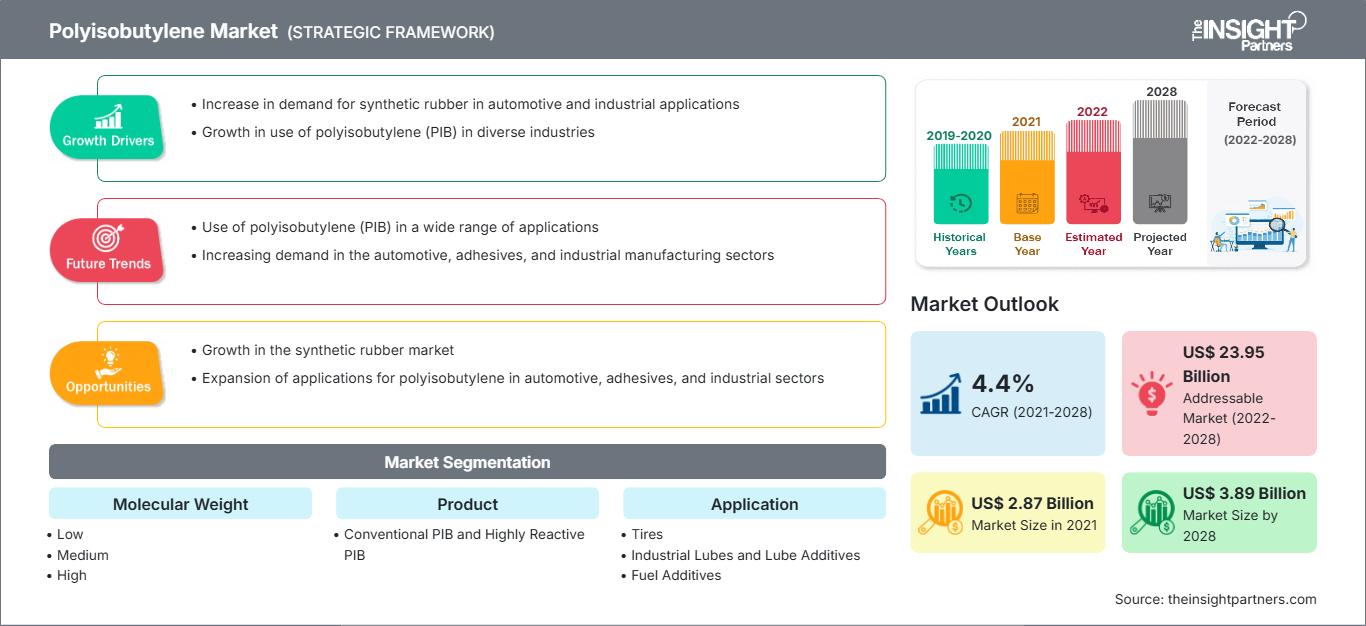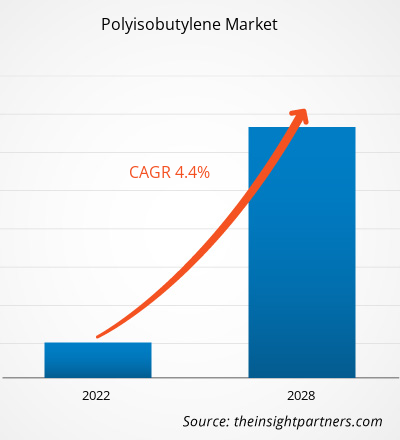[研究报告]2021年,聚异丁烯市场价值为28.7114亿美元,预计到2028年将达到38.9116亿美元;预计2021年至2028年的复合年增长率为4.4%。
聚异丁烯 (PIB) 是一种弹性体或合成橡胶。根据分子量,市场细分为低、中、高分子量。它是一种用途广泛、无毒、水白色的粘稠液体。聚异丁烯可以增加粘性、提供防水性、改善粘度指数并提供优异的电绝缘性。2020年,北美占据了全球聚异丁烯市场的最大收入份额。运输、农用化学品、电气和粘合剂等各种应用领域不断增长的需求推动了北美市场的增长。聚异丁烯因其低气体渗透性、优异的拉伸强度、高耐化学性和增加的刚度而越来越多地应用于运输、食品和建筑行业。
自定义此报告以满足您的要求
您将免费获得任何报告的定制,包括本报告的部分内容,或国家级分析、Excel 数据包,以及为初创企业和大学提供超值优惠和折扣
聚异丁烯市场: 战略洞察

- 获取本报告的主要市场趋势。这个免费样本将包括数据分析,从市场趋势到估计和预测。
您将免费获得任何报告的定制,包括本报告的部分内容,或国家级分析、Excel 数据包,以及为初创企业和大学提供超值优惠和折扣
聚异丁烯市场: 战略洞察

- 获取本报告的主要市场趋势。这个免费样本将包括数据分析,从市场趋势到估计和预测。
新冠疫情对聚异丁烯市场的影响
新冠疫情彻底改变了化学品和材料行业的现状,并对聚异丁烯市场的增长产生了负面影响。
全球化学品和材料行业是受疫情严重影响的主要行业之一,例如供应链中断、科技活动取消以及办公室关闭。欧洲、亚洲和北美各国实施的全球旅行禁令正在影响商业合作和伙伴关系机会。所有这些因素预计都会对电子行业、化学品和材料行业产生负面影响,从而阻碍与这些行业相关的各个市场的增长。然而,随着各经济体计划恢复运营,预计全球对聚异丁烯的需求将会上升。随着全球商业活动的恢复和封锁措施的解除,下游工业润滑油和润滑油添加剂行业对聚异丁烯的需求开始上升。市场洞察:汽车行业将在预测期内推动市场增长
对于汽车行业而言,发动机的性能对于日常功能至关重要。多年来,汽车行业一直是多种燃料添加剂的主要市场。由于缺乏高效的化石燃料替代品以及中产阶级经济的不断增长,汽车的市场份额一直高于其他燃料添加剂细分市场。近年来,航空燃料添加剂的相对重要性不断提升,最终推动了对聚异丁烯的需求。
应用洞察
根据应用,全球聚异丁烯市场细分为轮胎、工业润滑油和润滑油添加剂、燃料添加剂、粘合剂和密封剂等。 2020年,工业润滑油和润滑油添加剂领域占据了最大的市场份额。聚异丁烯(PIB)与马来酸酐反应生成聚异丁烯基琥珀酸酐(PIBSA),这是润滑油分散剂和燃料清洁剂的基本构成要素。其另一种衍生自聚异丁烯(PIB)的变体聚异丁烯-琥珀酰亚胺(PIBSI)可用作可溶性金属加工液中的抗氧化乳化剂和润滑油添加剂的构成要素。 PIB 燃烧更清洁,使其成为二冲程发动机油和船舶应用的理想选择,因为这些应用的润滑油会受到大型柴油发动机产生的强烈窜气的影响。
巴斯夫股份公司 (BASF SE)、巴西石油化工公司 (Braskem SA)、大林工业石油化工部门 (Daelim Industrial Petrochemical Division)、英力士股份公司 (Ineos AG)、润英联国际有限公司 (Infineum International Limited.)、科塔里石油化工公司 (Kothari Petrochemicals.)、西布尔控股有限公司 (Sibur Holding PJSC)、Kemat 聚丁烯公司 (Kemat Polybutenes)、路博润公司 (The Lubrizol Corporation) 和 TPC 集团 (TPC Group) 是全球聚异丁烯市场的主要参与者。市场参与者高度专注于开发高质量和创新的产品,以满足客户的需求。
聚异丁烯聚异丁烯市场区域洞察
The Insight Partners 的分析师已详尽阐述了预测期内影响聚异丁烯市场的区域趋势和因素。本节还讨论了北美、欧洲、亚太地区、中东和非洲以及南美和中美洲的聚异丁烯市场细分和地域分布。
聚异丁烯市场报告范围
| 报告属性 | 细节 |
|---|---|
| 市场规模 2021 | US$ 2.87 Billion |
| 市场规模 2028 | US$ 3.89 Billion |
| 全球复合年增长率 (2021 - 2028) | 4.4% |
| 历史数据 | 2019-2020 |
| 预测期 | 2022-2028 |
| 涵盖的领域 |
By 分子量
|
| 覆盖地区和国家 | 北美
|
| 市场领导者和主要公司简介 |
|
聚异丁烯市场参与者密度:了解其对业务动态的影响
聚异丁烯市场正在快速增长,这得益于终端用户需求的不断增长,而这些需求的驱动因素包括消费者偏好的转变、技术进步以及对产品优势的认知度的提升。随着需求的增长,企业正在扩大产品线,不断创新以满足消费者需求,并抓住新兴趋势,从而进一步推动市场增长。

- 获取 聚异丁烯市场 主要参与者概述
报告重点
- 聚异丁烯市场不断发展的行业趋势,帮助参与者制定有效的长期战略
- 发达市场和发展中市场采用的业务增长战略
- 2019 年至 2028 年聚异丁烯市场的定量分析
- 全球聚异丁烯需求估算
- 波特五力分析,阐明行业买家和供应商的效力
- 了解竞争激烈的市场形势的最新发展
- 市场趋势和前景,以及推动和抑制聚异丁烯市场增长的因素
- 通过强调支撑商业利益的市场策略来协助决策过程,从而促进市场增长
- 不同节点的聚异丁烯市场规模
- 市场以及聚异丁烯行业的详细概述和细分
- 各地区聚异丁烯市场规模及增长潜力
聚异丁烯市场
按分子量
- 低
- 中
- 高
- 产品
- 常规聚异丁烯
- 高反应性聚异丁烯
应用
- 轮胎
- 工业润滑油和润滑油添加剂
- 燃料添加剂
- 粘合剂和密封剂
- 其他
最终用途行业
- 工业
- 食品
- 其他
公司简介
- 巴斯夫欧洲公司
- 巴西石化公司SA
- 大林工业石油化工部门
- 英力士股份公司
- 润英联国际有限公司
- Kemat 聚丁烯
- 科塔里石油化工公司
- 西布尔控股公共股份公司
- 路博润公司
- TPC 集团
- 历史分析(2 年)、基准年、预测(7 年)及复合年增长率
- PEST和SWOT分析
- 市场规模、价值/数量 - 全球、区域、国家
- 行业和竞争格局
- Excel 数据集
近期报告
客户评价
购买理由
- 明智的决策
- 了解市场动态
- 竞争分析
- 客户洞察
- 市场预测
- 风险规避
- 战略规划
- 投资论证
- 识别新兴市场
- 优化营销策略
- 提升运营效率
- 顺应监管趋势






















 获取免费样品 - 聚异丁烯市场
获取免费样品 - 聚异丁烯市场